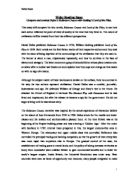How do the Writers show Children Learning From their Experiences?
In both Hill’s “I'm The King of The Castle” and Golding's “Lord of The Flies”, children are shown to learn from their experiences in three aspects: their respect for human life, responsibility when in power and their response to savagery. Both writers take a similar stance in how they portray the children's respect for life but differ slightly; Hill uses Hooper to show how disrespect for life leads to sadism while Golding shows how repeated exposure to death leads to desensitisation and thus a lack of respect for human life. Hill uses Hooper again to show how power leads to corruption while Golding demonstrates how it can lead to good. Finally, Hill shows Kingshaw as first being attracted by savagery but later as rejecting it and returning to civility whereas Golding portrays Jack as starting out civil and slowly being seduced by power being savage holds.
Hill uses Hoopers progression into sadism to highlight the dangers that come with inconsideration and disrespect for human life and Golding echoes this with his depiction of the boys desensitisation towards death which ends up leading them, like Hooper, to taking pleasure in the end of life. Hill shows Hoopers inconsideration towards death in the opening pages of the novel when she described Hooper as having “thought nothing of his grandfather” shortly after his death. This lack of care towards the death of a supposed loved ones shows not only his emotional disconnect with his family, but also his stance on life; at this point of time Hooper sees so significance in life or a living person and in this sense could be seen as nihilistic. Hill shows Hoopers descent into this disrespect through his relentless bullying of Kingshaw which shows his lack of respect for other people. His actions lead Kingshaw to committing suicide and when Hooper sees this he feels a “spurt of triumph”. Through this description Hill cements Hoopers stance as a sadist and thus shows him as being disrespectful towards life. Like Hill, Golding uses the reactions of the boy's to show their descent into sadism. The boys first encounter with death is the disappearance of the Mulberry birthmark boy at the end of chapter two. At this point the Piggy notices the boy is missing and when he asks the group about it Ralph responds “as if in shame”. While it is never confirmed as to what happened to the child, the assumption is that he died and this is what the rest of the boys believe and when confronted with this fact Ralph shows “shame”. This shows that Ralph acknowledges that something bad happened to the child and that he feels responsible/guilty and goes to show that as a whole the boys do show respect for life at this point. The next point at which the boys deal with death is the death of Simon. During Ralph's conversation with Piggy the day after, Golding describes Piggy as saying “we can't do no good thinking about it”. Piggy’s refusal to acknowledge his and Ralphs involvement in the murder and his prior comment stating that Simon was “ask[ing] for it” show a serious change in view. At this point Golding shows the boys as being more neutral in their view of life, with the exception of Ralph. This changes once again with the death of Piggy. When Piggy dies Jack exclaims “See? See? That's what you'll get”. The fact the Jack makes this threat following the death of Piggy, and that the tribe cheers him on for saying it, show that the boys no longer understand the significance of death and no longer respect human life. This has ties with the idea of British superiority that was held at time time. The belief stated that the British were civil and that the rest of the world were savages; Golding challenges this idea by instead proposing that all people are capable of savagery









